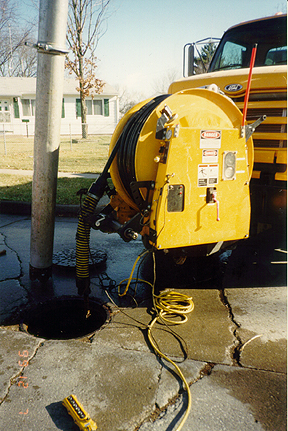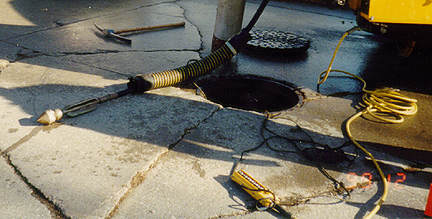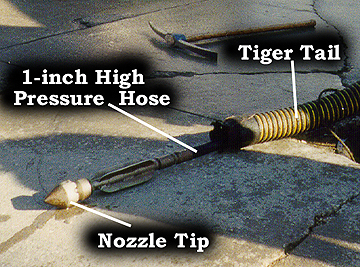

TO: Director, National Institute for Occupational Safety and Health
FROM: Iowa FACE Program Submission Date: 3/23/2000
SUBJECT: Sewer maintenance worker killed by nozzle tip on jet/vac hose.
SUMMARY
 On August 6, 1999,
a 29 year old male public works employee died when he was struck
by the nozzle of a high pressure water hose. Two employees were
doing routine cleaning of the sanitary sewer line using a combination
jet/vac truck equipped with a water-powered hose and nozzle. The
nozzle somehow came back up through the manhole and struck the
victim in the head. His co-worker was at the next manhole some
distance away, and not in visible sight due to a ravine and landscape
between the two positions. His co-worker stated that as the sewer
cleaning was in process, he heard the nozzle approaching his end
of the sewer line, indicating there were no obstructions in the
line, and radioed the victim. The victim started reeling the hose
back to the truck. The co-worker heard the truck idle down and
knew that the hose was back at the start of the sewer line. The
victim radioed the co-worker to confirm that he was shutting the
unit down. The co-worker started fastening down the manhole cover
following normal procedures, when he heard the truck idle back
up to operating speed. He then heard boys screaming and knew something
had happened. It took him some time to get through the ravine
and back to the truck. Upon arriving at the truck, he found the
victim lying by the manhole with massive head injuries. The nozzle
had somehow come back up through the manhole and struck the victim
in the head. Bystanders reported that they heard something explode
from the back of the truck. They saw the hose spraying water into
the air and the victim lying on the street, and immediately called
911. The city police and fire department responded, and the victim
was unconscious when they arrived. Life Flight helicopter was
notified and transported the victim to a local hospital. The victim
remained unconscious and died two days later.
On August 6, 1999,
a 29 year old male public works employee died when he was struck
by the nozzle of a high pressure water hose. Two employees were
doing routine cleaning of the sanitary sewer line using a combination
jet/vac truck equipped with a water-powered hose and nozzle. The
nozzle somehow came back up through the manhole and struck the
victim in the head. His co-worker was at the next manhole some
distance away, and not in visible sight due to a ravine and landscape
between the two positions. His co-worker stated that as the sewer
cleaning was in process, he heard the nozzle approaching his end
of the sewer line, indicating there were no obstructions in the
line, and radioed the victim. The victim started reeling the hose
back to the truck. The co-worker heard the truck idle down and
knew that the hose was back at the start of the sewer line. The
victim radioed the co-worker to confirm that he was shutting the
unit down. The co-worker started fastening down the manhole cover
following normal procedures, when he heard the truck idle back
up to operating speed. He then heard boys screaming and knew something
had happened. It took him some time to get through the ravine
and back to the truck. Upon arriving at the truck, he found the
victim lying by the manhole with massive head injuries. The nozzle
had somehow come back up through the manhole and struck the victim
in the head. Bystanders reported that they heard something explode
from the back of the truck. They saw the hose spraying water into
the air and the victim lying on the street, and immediately called
911. The city police and fire department responded, and the victim
was unconscious when they arrived. Life Flight helicopter was
notified and transported the victim to a local hospital. The victim
remained unconscious and died two days later.
RECOMMENDATIONS based on our investigation are as follows:
1. Employees must follow manufacturer's instructions when using equipment.
2. Safety issues should be re-emphasized periodically during staff meetings.
INTRODUCTION
On August 6, 1999, a public works employee died when he was struck by the nozzle (1 inch diameter) of a high-pressure hose. The Iowa FACE program became aware of the incident on August 9 through a newspaper article. A site visit was conducted on September 24, 1999 with FACE personnel and the city administrator. Photos of the incident were obtained from the city administrator, and incident information was obtained from the city administrator; police and medical examiner's reports; and the OSHA inspection file. Pictures of a similar nozzle assembly were taken at a later date.
The employer was a municipality which employed 65 full time city employees, with 21 employees in the Public Works Division (SIC code 4952). The victim had worked for the city for about one year as an equipment operator/laborer. He was trained on the combination jet/vac truck in February 1999, and had completed over 200 sewer cleaning jobs. On the day of the incident there was another co-worker at the site, but he was at the next manhole, approximately 500 feet away. The co-worker was not in visible sight due to a ravine and landscape between the two positions.
The city has an extensive safety program with written policies in safety procedures, and has had a good safety record in the past. Safety training is provided for new employees and annually thereafter. Employees assigned to the combination jet/vac process are trained individually on all aspects of the process for several weeks. The trainee works under the direct supervision of an experienced individual during the training process.
INVESTIGATION
 Jet-vac sewer cleaning
is done throughout the year, but occurs more frequently in the
summer and fall when rain causes debris to clog the sewer system.
The incident occurred during normal sewer cleaning, so only the
water jet portion of the truck was used. Since the sanitary sewer
line was not plugged, there was no need for vacuuming.
Jet-vac sewer cleaning
is done throughout the year, but occurs more frequently in the
summer and fall when rain causes debris to clog the sewer system.
The incident occurred during normal sewer cleaning, so only the
water jet portion of the truck was used. Since the sanitary sewer
line was not plugged, there was no need for vacuuming.
Each unit consists of at least two employees. One employee operates the combination jet/vac truck and the other employee attends the manhole upstream from the process.
The combination jet/vac process consists of a hose and nozzle that is propelled forward in the sanitary sewer line by high water pressure. Depending on the size and type of sewer line, a steel nozzle weighing 10-12 pounds, is placed on the end of the hose. The steel nozzle controls the rotation to clean the sewer walls. In this incident a 1-inch steel nozzle was used. The water pressure is usually 1100-1200 psi. at the nozzle, which corresponds to 80 gallons of water per minute delivered at the nozzle. This high water pressure allows the nozzle to propel the hose forward in a rotating manner to clear obstructions in the sewer line.
 Before the hose is
placed in the manhole, a section of thicker hose, called a 'tiger
tail' (see Photo 3) is placed on the outside of the hose/nozzle
assembly, using a split ring, in such a manner that the tiger
tail can not slide off the end of the hose. The tiger tail section
stays in the sewer opening to direct the hose assembly and protect
the hose from friction and wear. The tiger tail is connected separately
with a cord to the truck. The employee can view the tiger tail
/ hose assembly, using a halogen floodlight, by looking down through
the manhole.
Before the hose is
placed in the manhole, a section of thicker hose, called a 'tiger
tail' (see Photo 3) is placed on the outside of the hose/nozzle
assembly, using a split ring, in such a manner that the tiger
tail can not slide off the end of the hose. The tiger tail section
stays in the sewer opening to direct the hose assembly and protect
the hose from friction and wear. The tiger tail is connected separately
with a cord to the truck. The employee can view the tiger tail
/ hose assembly, using a halogen floodlight, by looking down through
the manhole.
On this occasion, both employees started work at 7:00 AM. Their job assignment for the day was to clean sanitary sewer lines using the combination jet/vac truck, a project that was started the day before. The first run of the day was a short 119-foot section. The two employees completed the usual setup to jet clean this short section, then progressed to the next section. The next manhole location was across a wooded creek draw about 254 feet away. They wrapped up the unit so it could be moved to that location. The victim told the co-worker to stay at their current location and that he would drive around to setup for the next section. As the victim was backing up the truck on an incline, the water alarm sounded. The victim stopped and made the comment that they may need water. After getting the truck back on level ground the victim determined that he had plenty of water to clean the next section. The co-worker waited as the victim drove to the next manhole location, and he heard the victim set the airbrakes on the truck. The victim then walked into the rear yard of the house that he was parked in front of to confirm with the co-worker that he had the right location. The co-worker acknowledged his location after which the victim returned to the truck to setup and clean this section.
The victim set up the hose and tiger tail in the manhole. The depth of the manhole was 24 feet, and the sanitary sewer line was 6-9 inches in diameter. The cleaning nozzle makes quite a bit of noise and it was easy for the co-worker to know when the unit was near the end of the sewer. The co-worker heard the nozzle approaching his end of the sewer line and radioed the victim. At this point, the victim started reeling the cleaning nozzle back to the truck. The co-worker heard the truck idle down and knew that the cleaning nozzle was back at the start of the sewer line, and could tell that the victim turned the water off since the normal sound of the water jetting had stopped.
Shortly thereafter, the victim radioed the co-worker that the hose was removed. The co-worker began to bolt down the manhole lid when he heard the truck idle back up to operating speed. Within 30 seconds or less, he heard boys screaming and knew something had happened. It took him several minutes to get to the truck because of the ravine. Upon arriving at the truck, he found the victim by the manhole with massive head injuries, and two emergency response individuals leaning over the victim rendering aid to him. Bystanders reported that they heard something explode from the back of the truck, making a noise similar to a loud bottle rocket. They saw the hose spraying water into the air and the victim lying on the street, and immediately called 911.
The co-worker noticed that the pump motor and truck engine were both still running so he immediately shut the pump motor off first and then the truck motor. The victim was wearing a hard hat at the time of the incident, and the hard hat was found on the pavement approximately 20 feet away. The flood light was also lying on the pavement.
When sewer cleaning is complete in one section of the sewer line, the normal procedure is to bring the tiger tail and nozzle up at the same time, remove the tiger tail from the split ring, attach the tiger tail in position on the truck, then wind the hose back onto the reel. For no apparent reason the victim removed the hose from the tiger tail assembly and put the hose back into the manhole and turned on the water pressure, possibly to clean out some debris. When the co-worker turned the water and pump off, he did not note the setting, but remembered that it sounded like the usual operating level of noise. The water was therefore at 1100-1200 psi. immediately at the nozzle.
It appears the nozzle somehow came back up through the manhole and struck the employee in the head, knocking him backward. The hose shot straight up in the air with water spraying out. As the unit began to run out of water the nozzle lost propellant and began to descend allowing tension out of the hose. As the hose went slack one wrap of it came off the hose reel. While water was still coming out, the nozzle and hose fell onto the north grass area. The grass beneath the nozzle was ‘trenched’ about 3-4 inches deep in a muddy area 4-5 feet in length. The street area was very wet and covered with grass clippings from the trenched area.
The manufacturer of the truck took the unit out of service for a number of days to review operating parameters. The truck was purchased two years previous to the incident. The pump had 195 operating hours logged and 550 hours were logged on the truck. The operating system and components were observed to be in good working condition, with only some items showing showed normal wear. The truck was put back into service following the review.
Crisis counseling was offered by the municipality for all workers. City offices were closed on the day of the funeral, so that city employees could attend the funeral.
CAUSE OF DEATH
The cause of death was craniocerebral trauma.
RECOMMENDATIONS / DISCUSSION
RECOMMENDATION #1 Employees should always follow manufacturer's instructions when operating equipment.
Discussion: The manufacturer's sewer cleaning operator's manual specifies the procedure to follow for operation of the combination jet/vac truck. Review sessions should emphasize that equipment should only be used following the manufacturer's recommended procedures. The sewer cleaning operator's manual states:
Extreme caution must be exercised when operating the unit since the water pressure can range from 500 - 2,000 psi. Failure to comply with any of the safety instructions may result in severe injury or death. Safe operation is the operator's responsibility. The jet vac unit should only be used for the purpose for which it was intended.
RECOMMENDATION #2 Safety work practices should be re-emphasized during staff meetings.
Discussion: In this situation, training was provided on the sewer cleaning process. In addition to this, employees should be reminded of the importance of safe work practices and the consequences of using equipment being operated under such high pressure.
______________________________________________________________________
| Lois Etre PhD. | Wayne Johnson M.D. |
| Industrial Hygienist/Investigator | Chief Trauma Investigator |
| Institute for Rural & Environmental Health | Institute for Rural & Environmental Health |
| The University of Iowa - Iowa City, Iowa | The University of Iowa - Iowa City, Iowa |